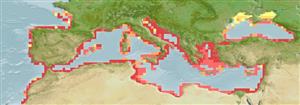Ajouter votre observation dans Fish Watcher
| Native range | All suitable habitat | Point map | Year 2050 |

|
| This map was computer-generated and has not yet been reviewed. |
| Chelon saliens AquaMaps Data sources: GBIF OBIS |
Envoyez vos Photos et vidéos
Pictures | Images GoogleChelon saliens
Picture by Abbasi, K.
Pictures | Images GoogleChelon saliens
Picture by Abbasi, K.
Bulgaria country information
Common names:
Ilaria
Occurrence: native
Salinity: freshwater
Abundance: | Ref:
Importance: | Ref:
Aquaculture: | Ref:
Regulations: | Ref:
Uses: no uses
Comments:
National Checklist:
Country Information: https://www.cia.gov/library/publications/resources/the-world-factbook/geos/bu.html
National Fisheries Authority:
Occurrences: Occurrences Point map
Main Ref: Hureau, J.-C. and T. Monod (eds.), 1979
National Database:
Occurrence: native
Salinity: freshwater
Abundance: | Ref:
Importance: | Ref:
Aquaculture: | Ref:
Regulations: | Ref:
Uses: no uses
Comments:
National Checklist:
Country Information: https://www.cia.gov/library/publications/resources/the-world-factbook/geos/bu.html
National Fisheries Authority:
Occurrences: Occurrences Point map
Main Ref: Hureau, J.-C. and T. Monod (eds.), 1979
National Database:
Common names from other countries
Classification / Names Noms communs | Synonymes | Catalog of Fishes(Genre, Espèce) | ITIS | CoL | WoRMS | Cloffa
> Mugiliformes (Mullets) > Mugilidae (Mullets)
Etymology: Chelon: Greek, chelone = turtle (Ref. 45335).
More on author: Risso.
Etymology: Chelon: Greek, chelone = turtle (Ref. 45335).
More on author: Risso.
Environment: milieu / climate zone / depth range / distribution range Écologie
marin; saumâtre démersal; profondeur 10 - ? m (Ref. 3573). Subtropical; 47°N - 29°N, 11°W - 42°E
Distribution Pays | Zones FAO | Écosystèmes | Occurrences | Point map | Introductions | Faunafri
Eastern Atlantic: Mediterranean Sea, the Black Sea, Sea of Azov and Atlantic coasts from Morocco to France. Introduced to Iran and is now naturally occurring in the Caspian Sea basin (Ref. 50218).
Length at first maturity / Taille / Poids / Âge
Maturity: Lm 21.3, range 17 - 22 cm
Max length : 40.0 cm SL mâle / non sexé; (Ref. 3397); common length : 30.0 cm TL mâle / non sexé; (Ref. 9987)
Max length : 40.0 cm SL mâle / non sexé; (Ref. 3397); common length : 30.0 cm TL mâle / non sexé; (Ref. 9987)
Adults usually in schools inhabit coastal waters (Ref. 3573); sometimes in lagoons and estuaries (Ref. 59043). Juveniles around 2.0 cm SL move to coastal lagoons and estuaries in summer and autumn (Ref. 59043). Adults are herbivorous feeding on algae and vegetal detritus while juveniles feed on zooplankton until about 3 cm SL, then on benthic organisms until 5 cm SL (Ref. 9987, 59043). Reproduce in summer (Ref. 2804). Oviparous, eggs are pelagic and non-adhesive (Ref. 205). Utilized for roe, but also fresh, smoked and frozen (Ref. 9987).
Life cycle and mating behavior Maturité | Reproduction | Frai | Œufs | Fécondité | Larves
Référence principale
Upload your references | Références | Coordinateur : Harrison, Ian | Collaborateurs
Thomson, J.M., 1986. Mugilidae. p. 344-349. In J. Daget, J.-P. Gosse and D.F.E. Thys van den Audenaerde (eds.) Check-list of the freshwater fishes of Africa (CLOFFA). ISNB, Brussels, MRAC; Tervuren; and ORSTOM, Paris. Vol. 2. (Ref. 3573)
Statut dans la liste rouge de l'IUCN (Ref. 130435: Version 2024-1)
Préoccupation mineure (LC) ; Date assessed: 01 January 2008
Menace pour l'homme
Harmless
Utilisations par l'homme
Pêcheries: intérêt commercial mineur; Aquaculture: commercial
FAO(pêcheries: production; publication : search) | FishSource | Sea Around Us
Plus d'informations
Trophic ecology
Éléments du régime alimentaire
Composition du régime alimentaire
Consommation alimentaire
Food rations
Prédateurs
Éléments du régime alimentaire
Composition du régime alimentaire
Consommation alimentaire
Food rations
Prédateurs
Population dynamics
Paramètres de croissance
Max. ages / sizes
Length-weight rel.
Length-length rel.
Fréquences de longueurs
Mass conversion
Recrutement
Abondance
Paramètres de croissance
Max. ages / sizes
Length-weight rel.
Length-length rel.
Fréquences de longueurs
Mass conversion
Recrutement
Abondance
Anatomy
Surface branchiale
Brain
Otolith
Surface branchiale
Brain
Otolith
Physiology
Body composition
Nutrients
Consommation d'oxygène
Type de nage
Vitesse de nage
Visual pigments
Fish sound
Diseases & Parasites
Toxicity (LC50s)
Body composition
Nutrients
Consommation d'oxygène
Type de nage
Vitesse de nage
Visual pigments
Fish sound
Diseases & Parasites
Toxicity (LC50s)
Human related
Aquaculture systems
Profils d'aquaculture
Souches
Ciguatera cases
Stamps, coins, misc.
Aquaculture systems
Profils d'aquaculture
Souches
Ciguatera cases
Stamps, coins, misc.
Outils
E-book | Guide de terrain | Clés d'identification | Générateur de fréquences de longueur | Outil de dynamique de population | Carte par point | Classification Tree
| Catch-MSY |
Articles particuliers
Télécharger en XML
Sources Internet
Alien/Invasive Species database | Aquatic Commons | BHL | Cloffa | Websites from users | FishWatcher | CISTI | Catalog of Fishes(Genre, Espèce) | DiscoverLife | ECOTOX | Faunafri | Fishtrace | GenBank(génôme, nucléotide) | GloBI | GOBASE | | Google Books | Google Scholar | Google | IGFA World Record | MitoFish | Bases de données nationales | Otolith Atlas of Taiwan Fishes | Aquariums publics | PubMed | Reef Life Survey | Scirus | SeaLifeBase | Arbre de Vie | Wikipedia(aller à, chercher) | World Records Freshwater Fishing | Zoological Record
Estimates based on models
Preferred temperature (Ref. 115969): 14.4 - 21.5, mean 18.4 (based on 154 cells).
Phylogenetic diversity index (Ref. 82804): PD50 = 0.5005 [Uniqueness, from 0.5 = low to 2.0 = high].
Bayesian length-weight: a=0.01072 (0.00898 - 0.01278), b=2.96 (2.93 - 2.99), in cm Total Length, based on LWR estimates for this species (Ref. 93245).
Niveau trophique (Ref. 69278): 2.9 ±0.38 se; based on food items.
Résilience (Ref. 120179): Milieu, temps minimum de doublement de population : 1,4 à 4,4 années (K=0.2-0.3; tm=3-4).
Fishing Vulnerability (Ref. 59153): Moderate to high vulnerability (45 of 100).
Climate Vulnerability (Ref. 125649): Moderate vulnerability (39 of 100).




